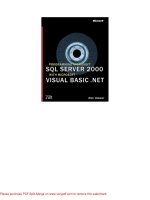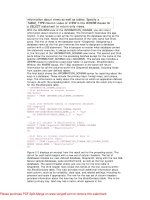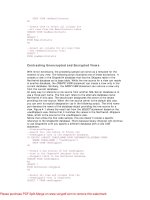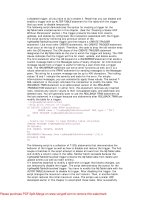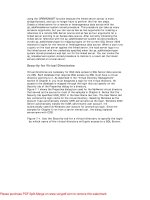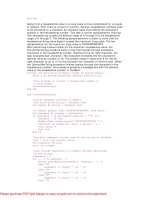professional scrum development with microsoft visual studio 2012
Bạn đang xem bản rút gọn của tài liệu. Xem và tải ngay bản đầy đủ của tài liệu tại đây (27.28 MB, 385 trang )
Professional Scrum
Development with
Microsoft
®
Visual
Studio
®
2012
Richard Hundhausen
Praise for this book
“Richard provides real Scrum guidance for real teams. If you’re a Scrum team using Visual Studio, this
book is a great resource.”
—Aaron Bjork, Principal Group Program Manager, Team Foundation Server, Microsoft
“Richard successfully marries the best tools for .NET developers to the most effective practices
withoutsacricingthepeople.”
—David Starr, Senior Program Manager, Visual Studio, Microsoft
“Finally, a book about Scrum from the Development Team’s point of view; Richard’s description of
thebestandworstwaystoimplementScrumispriceless.Therstchapteraloneisoneofthebest
descriptions of ‘Scrum done well’ that I’ve ever seen.”
—Charles Bradley, Scrum Coach & Professional Scrum Master
“TheveryrstbookonTeamFoundationServerthatIreadwaswrittenbyRichard,andhe’sdoneit
again this time with another fantastic read.”
—Brian Keller, Principal Technical Evangelist for Microsoft Visual Studio
“Richard does a fantastic job of blending theory, practice, and tools in one easy to read book!
This book will surely be a staple for many of our Scrum coaching engagements.”
—Chad Albrecht, VP Centare, PST
“As an encore to helping introduce the industry shaking Professional Scrum Developer program,
Richard reminds us in this book why he’s a leading voice in Scrum and Visual Studio ALM.”
—Ryan Cromwell, Professional Scrum Trainer, MVP
“I’ve known Richard a long time and it’s been great to follow his progression towards becoming a
Scrum ‘white robe.’ I’m so happy the community now has the ultimate resource on understanding the
marriage of Scrum and TFS.”
—Adam Cogan, Microsoft Regional Director, Visual Studio ALM MVP [of the year 2011]
“If you’re new to Scrum or even if you’ve been doing it for a while, this book will help you get the
big picture.”
—Benjamin Day, Professional Scrum Trainer, MVP
“If you’re using Scrum and TFS and you haven’t read this book, then you’re probably doing it wrong.”
—Brian Randell, MCW Technologies, Visual Studio ALM MVP
“In this book, Richard uses the core values of Scrum to describe how to get the best Scrum adoption
of Visual Studio 2012. This is a superb combination of principles and mechanics that should be on all
teams’ bookshelves.”
—Simon Reindl Professional Scrum Developer Trainer
“I don’t keep a lot of technology books on my bookshelf due to the pace at which developer tools
evolvebutthisbook,withitsfocusonpeopleandprocesses,isdenitelyakeeper.Richard’sbookis
to Scrum development as Petzold’s was to Windows development.”
—Charles Sterling, Visual Studio Senior Program Manager, Microsoft
“Among the plethora of Scrum literature out there, Richard’s book makes a difference by bringing
Scrum closer to where it belongs: the day-to-day work in the context of a team, supported by suitable
practices,andthestate-of-the-artVisualStudiotoolset.You’llbenetfrommostoftheadviceit
contains, even if you don’t use Visual Studio!”
—Jose Luis Soria, Plain Concepts ALM Team Lead, PST
“Scrum, Visual Studio, and Team Foundation Server are just tools, and they will not make you better
by themselves. If you really want to improve you need to understand the tools and learn how to
improve,anddenitively,Richard’sbookwillhelpyoutogetthere”
—Luis Fraile, Visual Studio ALM MVP, Globe ALM Division Manager
“A masterpiece which distills the world of Scrum in a Visual Studio environment; anyone who is using
Scrum will recognize many of the ‘smells’ and appreciate the sharing of real-world experience and
guidance.”
—Willy-Peter Schaub, Program Manager, Visual Studio ALM Rangers
“This book should be required reading for everyone on your team. It will help you bring people,
processes, and technology together quickly with Scrum.”
—Mike Vincent, Professional Scrum Developer Trainer, Visual Studio ALM MVP
Professional Scrum
Development with
Microsoft
®
Visual
Studio
®
2012
Richard Hundhausen
PUBLISHED BY
Microsoft Press
A Division of Microsoft Corporation
One Microsoft Way
Redmond, Washington 98052-6399
Copyright © 2012 by Richard Hundhausen. Appendix copyright Ken Schwaber
and Jeff Sutherland.
All rights reserved. No part of the contents of this book may be reproduced or
transmitted in any form or by any means without the written permission of the
publisher.
Library of Congress Control Number: 2012948863
ISBN: 978-0-7356-5798-4
Printed and bound in the United States of America.
First Printing
Microsoft Press books are available through booksellers and distributors worldwide.
If you need support related to this book, email Microsoft Press Book Support at
Please tell us what you think of this book at
/>Microsoft and the trademarks listed at />IntellectualProperty/Trademarks/EN-US.aspx are trademarks of the Microsoft group of
companies. All other marks are property of their respective owners.
The example companies, organizations, products, domain names, email addresses, logos,
people,places,andeventsdepictedhereinarectitious.Noassociationwithanyreal
company, organization, product, domain name, email address, logo, person, place, or
event is intended or should be inferred.
This book expresses the author’s views and opinions. The information contained in
this book is provided without any express, statutory, or implied warranties. Neither the
authors, Microsoft Corporation, nor its resellers, or distributors will be held liable for any
damages caused or alleged to be caused either directly or indirectly by this book.
Acquisitions and Developmental Editor: Devon Musgrave
Project Editor: Rosemary Caperton
Editorial Production: Christian Holdener, S4Carlisle Publishing Services
Copyeditor: Andrew Jones
Indexer: Jean Skipp
Cover: Twist Creative∙ Seattle
This book is dedicated to my Scrum Team: Esmay, Isla, Berlin,
Blaize, Sawyer, and Kristen.
Contents at a Glance
Foreword xv
Introduction xix
PART I FUNDAMENTALS
CHAPTER 1 Scrumdamentals 3
CHAPTER 2 Microsoft Visual Studio 2012 ALM 41
CHAPTER 3 Microsoft Visual Studio Scrum 2.0 57
PART II USING SCRUM
CHAPTER 4 The pre-game 93
CHAPTER 5 The Product Backlog 127
CHAPTER 6 The Sprint 169
CHAPTER 7 Acceptance test-driven development 197
CHAPTER 8 Effective collaboration 227
PART III IMPROVING
CHAPTER 9 Continuous improvement 275
Appendix: The Scrum Guide 327
Index 341
ix
Contents
Foreword xv
Introduction xix
Who should read this book xix
Who should not read this book xx
Organization of this book xx
Conventions and features in this book xxi
Code samples xxii
Acknowledgments xxiii
Errata & book support xxiii
We want to hear from you xxiv
Stay in touch xxiv
PART I FUNDAMENTALS
Chapter 1 Scrumdamentals 3
The Scrum Guide 3
Scrum in action 4
Scrum roles 6
Scrum events 14
Scrum artifacts 27
Denitionof“Done” 36
The professional Scrum developer 37
Chapter burndown 39
x Contents
Chapter 2 Mircosoft Visual Studio 2012 ALM 41
Delivering continuous value 42
Visual Studio 2012. . . . . . . . . . . . . . . . . . . . . . . . . . . . . . . . . . . . . . . . . . . . . . . .44
Editions. . . . . . . . . . . . . . . . . . . . . . . . . . . . . . . . . . . . . . . . . . . . . . . . . . . .46
Team Foundation Server 51
Team Foundation Service 52
Visual Studio Team Explorer Everywhere 2012 54
MSDN subscriptions. . . . . . . . . . . . . . . . . . . . . . . . . . . . . . . . . . . . . . . . .54
Chapter burndown 55
Chapter 3 Microsoft Visual Studio Scrum 2.0 57
Dissecting the process template 57
MSF process templates 59
Exploring a process template 59
Visual Studio Scrum 2.0 61
What’s new and different 62
Work item types 67
Work item queries 81
Reports 83
Common customizations 86
Chapter burndown 88
PART II USING SCRUM
Chapter 4 The pre-game 93
Setting up the development environment 94
Team Foundation Server: Buy vs. build 94
Create a team project collection 96
CongureTeamFoundationBuild 97
CongureLabManagement 100
Setting up product development. . . . . . . . . . . . . . . . . . . . . . . . . . . . . . . . . .103
Create a team project 103
Source control 108
Contents xi
Automated builds 113
Project portal 115
Reports 118
Security groups 121
Teams 122
Chapter burndown 124
Chapter 5 The Product Backlog 127
Creating the Product Backlog 127
Team Web Access 128
Using the “quick add” experience 130
Handling epic PBIs 134
Importing existing PBIs 137
Reporting a bug 140
Effective Product Backlog creation 147
Grooming the Product Backlog 149
Specifying acceptance criteria 150
Estimating items in the Product Backlog 152
Tracking estimates in the Product Backlog 155
Ordering the Product Backlog 156
Planning a release 160
Time-driven vs. feature-driven releases 161
Controlling and prioritizing scope 161
Using Velocity to estimate 162
Release Burndown report 166
Chapter burndown 167
Chapter 6 The Sprint 169
Creating the Sprint Backlog 170
Forecasting the PBIs 170
Capturing the Sprint Goal 173
Creating the plan 174
Daily Scrum activities 179
xii Contents
The Daily Scrum 180
Taking on work 183
The task board 185
Chapter burndown 196
Chapter 7 Acceptance test-driven development 197
Keep the conversation going 198
Collaborativespecications 199
Executablespecications 201
Acceptance test-driven development 202
Test-driven development 205
Automated acceptance testing. . . . . . . . . . . . . . . . . . . . . . . . . . . . . . . . . . . .206
Creating a test case 206
Associating an automated test 210
Executing automated acceptance tests 214
Reusing test cases 217
Other acceptance-testing frameworks 221
Acceptance 224
Chapter burndown 225
Chapter 8 Effective collaboration 227
Individuals and interactions over processes and tools 227
Listen actively 229
Collocate 230
Set up a team room 232
Meet effectively 233
Collaborate productively 234
Achieve continuous feedback 236
Collaborative development practices 237
Collective code ownership 238
Commenting in code 240
Code reviews 241
Contents xiii
Collaborative development tools 244
Team Foundation Server 244
Continuous integration 245
Gated check-in builds 249
Email alerts 250
Shelving 253
My Work 254
PowerPoint Storyboarding 257
Feedback client 261
Code reviews 267
Chapter burndown 271
PART III IMPROVING
Chapter 9 Continuous improvement 275
Common challenges 275
Bugs 276
Impediments 277
Estimation 279
Assessing progress 282
Renegotiating scope 286
Undone work 288
Spikes 293
Fixed-Price contracts and Scrum 294
Common dysfunctions 296
Not getting “done” 297
Flaccid Scrum 298
Not inspecting, not adapting 299
Development Team challenges 300
Working with a challenging Product Owner 304
Working with challenging stakeholders 307
Working with a challenging Scrum Master 309
Changing Scrum 312
Improving 315
Get a coach 315
Build a cross-functional team 316
Achieve self-organization 317
Improve transparency 318
Swarm 319
Use a Kanban board to limit WIP 319
Professional Scrum Developer training 322
Assess your knowledge 322
Become a high-performance Scrum Development Team. . . . . . . .323
Chapter burndown 324
Appendix: The Scrum Guide 325
Index 341
xv
Foreword
B
y 2001, the software industry was in trouble—more projects were failing than
succeeding. Customers began demanding contracts with penalties, and increasingly
sending work offshore. Some software developers, though, had increasing success with
a development process known as “lightweight.” Almost uniformly, these processes were
based on the well-known iterative, incremental process.
In February of 2001, these developers issued a manifesto—the Agile Manifesto.
The Manifesto called for Agile software development based on 4 principle values and
12 underlying principles. Two of the principles were 1.) to satisfy customers through
early and continuous delivery of working software, and 2). to deliver working software
frequently, from a couple of weeks to a couple of months, with a preference to the
shorter timescale.
By 2008, the Scrum Agile process was used predominantly. A simple framework, it
provided an easily adopted iterative incremental framework for software development.
It also incorporated the Agile Manifesto’s values and principles. The two authors of
Scrum, Jeff Sutherland and myself, also were among the authors of the Agile Manifesto.
Ihadanticipatedsomeofthedifcultiesorganizations(andeventeams)would
face when they adopted Scrum. However, I believed that developers would bloom in
aScrumenvironment.Stiedandchokedbywaterfall,developerswouldstandtall,
employing development practices, collaboration, and tooling that nobody had time to
use in waterfall projects.
Much to my surprise, this was only true for perhaps 20 percent of all software
developers.
Note In 2007, Martin Fowler characterized most Agile software development
as“accid.”Hestated:There’samessI’veheardaboutwithquiteafew
projects recently. It works out like this:
■
They want to use an Agile process, and pick Scrum.
■
They adopt the Scrum practices, and maybe even the principles.
■
After a while, progress is slow because the code base is a mess.
xvi Foreword
What’s happened is that they haven’t paid enough attention to the internal
qualityoftheirsoftware.Ifyoumakethatmistakeyou’llsoonndyour
productivity dragged down because it’s much harder to add new features
than you’d like. You’ve taken on a crippling Technical Debt and your Scrum
hasgoneweakattheknees.(Andifyou’vebeeninarealscrum,you’llknow
that’s a Bad Thing.) />Martin’sdescriptionofaccidScrumresonatedwithourexperience.Mostdevelopers
were skilled, but not adequately skilled in the three dimensions required to rapidly
build complete increments of usable functionality. These dimensions are:
People The ability to work in a small, cross-functional, self-organizing team.
Practices The knowledge of and ability to apply modern engineering
practices that short cycle development mandates.
Tooling Tools that integrated and automated these practices so that
successive increments could be rapidly integrated without the drag of
exponentially accruing artifacts that must be handled manually.
We put our business on hold while we worked through 2008 to create what has
become known as the Professional Scrum Developer program. Offered in both a
three-andve-dayformat,weformulatedaworkshop.Theinputwasdevelopers
whoseknowledgeandcapabilitiesproducedaccidincrements.Theoutputwereteams
of developers who had developed solid increments of software called for by the Agile
Manifesto and demanded by the modern, competitive organization.
Richard has been there since the beginning. His book, Professional Scrum
Development with Microsoft® Visual Studio® 2012 continues his participation in the
movement started by us few in 2009.
When you read Richard’s book, you can learn the three dimensions needed for
Agile software development: people, process, and tools. Just like the course, Richard
intertwines them into something you can absorb. If you are on a Scrum team, read
Richard’s book. List the called-for practices. Identify which practices pose challenges to
your team. Order them by their greatest impact. Then remediate them, one by one.
Many people spend money going to Agile conferences. Save the money and
more by buying this book, discussing it with others, and going to Code Camps, the
“ un- conference” for the serious.
Foreword xvii
Richard and I look forward to your increased skill. Our industry and our society need
it. Software is the last great scalable resource needed by our increasingly complex
society. The effective, productive teamwork of Agile teams is the basis of problem
solving that our society also needs.
Scrum on!
Ken Schwaber
co-creator of Scrum
September, 2012
In 2009, Richard took on a daunting task. Ken Schwaber and I came together because
we lamented the impediment facing software teams trying to improve their ability to
deliver customer value on frequent, short cadence. They could learn about practices,
they could learn about tools, or they could engage coaching, but putting it all together
was an exercise left to the readers.
That’s when Richard Hundhausen stepped into the breach. He put together
Professional Scrum Developer in a whirlwind. Quite literally, he toured the world
delivering beta courses, relentlessly receiving feedback, and inspecting and adapting.
Theresultwasthersthighlyscalabletrainingprogramthatcombinedmodern
software engineering practices and readily available tooling at the global scale. Richard
has been improving the course for three years through a dedicated community of
certiedtrainersandhasnowdistilledthebasicsintoaneasilyaccessiblebook.
If you’re new to Scrum and want to get better at delivering high-quality software
that your customers want quickly, Professional Scrum Developer is a great place to start.
Sam Guckenheimer
Product Owner, Visual Studio Product Line
Microsoft Corporation
September, 2012
xix
Introduction
S
crum is a framework for developing and sustaining complex products, such
assoftware.Scrumisjustasetofrules,asdenedintheScrum Guide (www.scrum
.org/Scrum-Guides), and it describes the roles, events, and artifacts, as well as the
rules that bind them together. When used correctly, this framework enables a team to
address complex problems while productively and creatively delivering products of the
highest possible value. Scrum is an Agile method. In fact, it is the most popular Agile
method in use today.
Scrum employs an iterative and incremental approach to optimizing predictability
and controlling risk. This is due to the empirical process control nature of Scrum.
Through proper use of inspection, adaptation, and transparency, a Scrum Team can try
anewwayofdoingsomething(anexperiment)andgaugeitsusefulnessafterashort
iteration. They can then collectively decide to embrace, extend, or drop the practice.
This includes the tools a team uses and how they use them.
CombiningScrumwiththeapplicationlifecyclemanagement(ALM)toolsfoundin
Microsoft Visual Studio 2012 is a powerful combination. It is the purpose of this book
to establish a baseline understanding of Scrum, as well as how Scrum is supported
in Visual Studio 2012. I will also illustrate which practices provide more value when
executed without the use of tools. In addition, I will point out those tools which have been
erroneously marketed as healthy when used by a collocated, collaborative Scrum Team.
In software development, anything and everything can change in a moment’s notice.
Healthy teams know this. They also know that continuously inspecting and adapting the
way things are done is a way of life. High-performance Scrum Development Teams take
itastepfurther.Theyknowthatwithineverydysfunctionorimpedimentidentiedisan
opportunitytolearnandimprove.Readingthisbookisagreatrststep.
Who should read this book
This book will be of value to any members of a software development team using
Scrum.Iprimarilyfocusontheresponsibilitiesandtasksofthedeveloper(whichin
Scrum includes designers, architects, coders, testers, technical writers, etc.). Product
Owners and Scrum Masters will also derive value from this book, as they will be using
xx Introduction
many of the same Visual Studio tools to plan and manage their work and assess
progress. Stakeholders, including customers, users, and managers, will also gain value
from this book, especially when they learn what they can and cannot do according to
the rules of Scrum and which tools in Visual Studio support this.
Who should not read this book
This book is intended for teams using Scrum and Visual Studio 2012 together. It won’t
provide as muchvalueforteamsexecutingAgile(non-Scrum)softwaredevelopment
and won’t provide any value for teams running more formal “waterfall” software
development projects, although Chapter 1 may hopefully change the minds of such
proponents. Likewise, if a team is using Scrum, but not yet using Visual Studio 2012,
the bulk of the book won’t be very interesting. This is also the case for teams using
Visual Studio 2012 Express or Professional editions, which don’t contain the high-value,
team -based tools for planning and managing the backlogs and team collaboration.
Organization of this book
This book is divided into three sections, each of which focuses on a different aspect
of the marriage of Scrum and Visual Studio. Part I, “Fundamentals,” sets a baseline
understanding of the Scrum framework, Visual Studio 2012 editions and their
interesting ALM features, as well as the Visual Studio Scrum 2.0 process template.
Part II, “Using Scrum,” provides several chapters detailing the practical application
of how a Scrum Team would use the relevant features of Visual Studio 2012. Part III,
“ Improving,” includes a chapter on identifying common challenges and dysfunctions
in order to remove them, as well as techniques to continually improve your game of
Scrum. By reading all sections sequentially, you will see how Visual Studio and
Scrum can be used together in an effective way and how a team can become
high - performance in the way it develops software.
Finding your best starting point in this book
The different sections of Professional Scrum Development with Microsoft Visual
Studio 2012 cover a range of topics. Depending on your needs and your existing
understanding of Scrum, Visual Studio, and the related development practices, you may
wishtofocusonspecicareasofthebook.Usethefollowingtabletodeterminehow
best to proceed through the book.
Introduction xxi
If you are Follow these steps
New to Scrum or have never heard of it Read Chapter 1
New to Visual Studio 2012 or its ALM tools Read Chapter 2
New to the Visual Studio Scrum process template or want to
know what’s new in version 2.0
Read Chapter 3
Familiar with Scrum and Visual Studio and only want to learn how
to setup and manage a Product Backlog.
Read Chapters 4 and 5
Familiar with Scrum and Visual Studio and only want guidance
on overcoming common challenges and dysfunctions.
Read Chapter 9
Conventions and features in this book
This book presents information using conventions designed to make the information
readable and easy to follow.
■
Screenshots from relevant Visual Studio 2012 features are provided for your
reference.
■
Boxed elements with labels such as “Note” or “Tip” provide additional
information and guidance related to the subject.
■
Some notes and tips are practical guidance provided by fellow Professional
Scrum Developers who have helped review this book.
In addition, I have included two additional boxed elements, one labeled “Smells” and the
other labeled “Tailspin Toys Case Study.”. These are discussed in the following sections.
Smells Throughoutthisbook,Ipointoutspecicsituationsandtrapsthat
a Scrum Team should avoid. I refer to these as smells. These smells typically
indicate an underlying dysfunction or other unhealthy behavior. For teams
new to Scrum, these smells may be hard to identify. Once they are brought
to light, however, they should be used as learning opportunities. As a team
improves, it should be able to recognize dysfunction on its own, as well
as remove it. High-performance Scrum Teams reach the ability to identify
potentialwaste,evaluatetherisks,andevendecidetoopt-intospecic
behaviors, including those that may be a smell to the uneducated.
xxii Introduction
Tailspin Toys case study Asyouipthroughthepages,youwillreadabout
TailspinToysasacasestudy.Thisisactitiousorganizationandteamthatis
building an online retail website that sells model aircraft and accessories. The
team has been using Scrum for some time and is moving to Visual Studio 2012.
My opinions on healthy and unhealthy behaviors are made evident through the
choices made by the Tailspin Toys team.
Code samples
Although this book contains almost no code samples, I did build a utility application
to help create and manage the Product Backlog and Sprint Backlog. This helped me
prepare the data seen in the various screen captures in this book. I affectionately
named this utility the Scrum Robot. The source code is yours if you think it can be
helpful. If nothing else, it demonstrates how to connect to a Team Foundation Server
2012 instance and manipulate basic team project data. The Scrum Robot can be
downloaded from the book’s companion content page:
/>Note You will need to have Visual Studio 2012 with Team Explorer installed
in order to use the Scrum Robot.
Installing and using the Scrum Robot
Follow these steps to install the Scrum Robot on your computer so that you can
programmatically access Team Foundation Server and manipulate a team project’s
areas, iterations, Product Backlog, and Sprint Backlog.
1. Unzip the ScrumRobot.ziplethatyoudownloadedfromthebook’swebsite
(nameaspecicdirectoryalongwithdirectionstocreateit,ifnecessary).
2. If prompted, review the displayed end user license agreement. If you accept the
terms, select the accept option, and then click Next.
Introduction xxiii
Note If the license agreement doesn’t appear, you can access
it from the same webpage from which you downloaded the
ScrumRobot.ziple.
3. Once unzipped, you can open the ScrumRobot.sln solution and review the code.
Press F5 to run the utility after changing any variables or constants, such as the
name and address of your Team Foundation Server.
Acknowledgments
There are several people who helped me write this book: Christian Holdener, for his
innitepatience.DevonMusgraveandRosemaryCaperton,foryetanotheropportunity
to write for Microsoft Press. Fellow Professional Scrum Developers: Mike Vincent, Simon
Reindl, Jose Luis Soria, David Starr, Jeroen van Menen, Chad Albrecht, Ryan Cromwell,
Luis Fraile, Rob Maher, and Peter Gfader for helping me sharpen the message. Fellow
Scrum and Visual Studio practitioners: Charles Bradley, Bob Hardister, Graham Barry,
Anna Russo, Christofer Löf, Willy-Peter Schaub, and Peter Provost for providing great
ideas and reviews. Thank you everyone.
Errata & book support
We’ve made every effort to ensure the accuracy of this book and its companion
content. Any errors that have been reported since this book was published are listed on
our Microsoft Press site at oreilly.com:
/>Ifyoundanerrorthatisnotalreadylisted,youcanreportittousthroughthe
same page.
If you need additional support, email Microsoft Press Book Support at
Please note that product support for Microsoft software is not offered through the
addresses above.
xxiv Introduction
We want to hear from you
At Microsoft Press, your satisfaction is our top priority, and your feedback our most
valuable asset. Please tell us what you think of this book at:
/>The survey is short, and we read every one of your comments and ideas. Thanks in
advance for your input!
Stay in touch
Let’s keep the conversation going! We’re on Twitter: />




